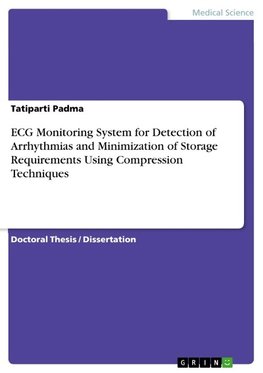
-
 Anglický jazyk
Anglický jazyk
ECG Monitoring System for Detection of Arrhythmias and Minimization of Storage Requirements Using Compression Techniques
Autor: Tatiparti Padma
Doctoral Thesis / Dissertation from the year 2014 in the subject Medicine - Biomedical Engineering, grade: A, , course: PhD, language: English, abstract: The main purpose of the present work is to design and implement a prototype ECG system with wireless... Viac o knihe
Na objednávku
49.05 €
bežná cena: 54.50 €
O knihe
Doctoral Thesis / Dissertation from the year 2014 in the subject Medicine - Biomedical Engineering, grade: A, , course: PhD, language: English, abstract: The main purpose of the present work is to design and implement a prototype ECG system with wireless links for continuous monitoring of the subject for cardiac related problems. The ECG signal acquired from subject is filtered, digitized, and compressed for wireless communication. The proposed system can be extended, upon interfacing with other devices, for continuous monitoring of other vital parameters of the patient. In automation of the ECG signal analysis, the workload of the medical professionals can be reduced. The automated system provides an alert when critical changes are detected by the system. Concisely stated, ECG of the patient is continuously monitored and deviations from normalcy are detected in real-time. The changes in the ECG could be due to heart attack, fibrillation or arrhythmias. In case of emergency, data is transmitted to a medical practitioner, who in turn can provide necessary directions to take care of the situation. In this manner, as the problems can be detected as and when they occur, the remedial actions are initiated before the problems become serious. The complete ECG diagnostic system includes a low power Instrumentation amplifier, filters, ADC, Microcontroller and ZIGBEE modules. MATLAB / LABVIEW are used for signal analysis and classification. These environments are capable of not only collecting, recording, transmitting, and displaying ECG data on a real time basis but also for analyzing the acquired ECG data in order to detect the cardiac abnormalities. The MIT-BIH database signals were used for validation and evaluation of classification algorithms. In order to reduce the memory requirements for storing the acquired ECG signals, ECG data was compressed. Discrete Cosine Transform (DCT) technique was applied for ECG data compression. Here DCT showed good performance with a Compression Ratio (CR) of 82-90.43% and Percent Root Mean Difference (PRD) of 7.9-0.93. Linear Vector Quantization method (LVQ) is used for identifying the abnormalities associated with the ECG signal. After training the LVQ process with a reasonable number of samples, the algorithm is used for classifying ECG signals. The techniques used in the present work for ECG signal compression and classification gave better results compared to those found in the literature.
- Vydavateľstvo: GRIN Verlag
- Rok vydania: 2022
- Formát: Paperback
- Rozmer: 210 x 148 mm
- Jazyk: Anglický jazyk
- ISBN: 9783346640048












